 |
 |
Our enthusiastic and extremely knowledgeable perennials team is here to answer your questions and help you choose the best perennials for your situation. There’s always something in bloom for sun, shade, butterflies, birds or deer resistance as well as a variety of bulbs for your space.
Stroll through our time-tested favorites and introduce yourself to the newest varieties. We garden with perennials too; we love them and it shows!
|
16 found, showing page 1 of 2
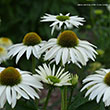
True-white flowers. Upright, clump-forming. Extended bloom cycle. USDA 3-9
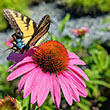
Plant Height: 24 inches
Flower Height: 3 feet
Spread: 24 inches
Sunlight: full sun
Hardiness Zone: 3a
Description:
A long flowering variety producing a profusion of ruby-pink flowers from mid-summer to early fall; a vigorous grower with sturdy stems, it really stands out in the late summer garden
Ornamental Features:
Ruby Star Coneflower has masses of beautiful lightly-scented crimson daisy flowers with brown eyes at the ends of the stems from mid summer to mid fall, which are most effective when planted in groupings. The flowers are excellent for cutting. Its pointy leaves remain green in color throughout the season.
Landscape Attributes:
Ruby Star Coneflower is an herbaceous perennial with an upright spreading habit of growth. Its medium texture blends into the garden, but can always be balanced by a couple of finer or coarser plants for an effective composition.
This is a relatively low maintenance plant, and is best cleaned up in early spring before it resumes active growth for the season. It is a good choice for attracting butterflies to your yard, but is not particularly attractive to deer who tend to leave it alone in favor of tastier treats. It has no significant negative characteristics.
Ruby Star Coneflower is recommended for the following landscape applications:
- Mass Planting
- General Garden Use
- Container Planting
Planting & Growing:
Ruby Star Coneflower will grow to be about 24 inches tall at maturity extending to 3 feet tall with the flowers, with a spread of 24 inches. It grows at a medium rate, and under ideal conditions can be expected to live for approximately 10 years. As an herbaceous perennial, this plant will usually die back to the crown each winter, and will regrow from the base each spring. Be careful not to disturb the crown in late winter when it may not be readily seen!
This plant should only be grown in full sunlight. It is very adaptable to both dry and moist locations, and should do just fine under typical garden conditions. It is considered to be drought-tolerant, and thus makes an ideal choice for a low-water garden or xeriscape application. It is not particular as to soil type or pH. It is highly tolerant of urban pollution and will even thrive in inner city environments. This is a selection of a native North American species. It can be propagated by division; however, as a cultivated variety, be aware that it may be subject to certain restrictions or prohibitions on propagation.
Ruby Star Coneflower is a fine choice for the garden, but it is also a good selection for planting in outdoor pots and containers. With its upright habit of growth, it is best suited for use as a 'thriller' in the 'spiller-thriller-filler' container combination; plant it near the center of the pot, surrounded by smaller plants and those that spill over the edges. It is even sizeable enough that it can be grown alone in a suitable container. Note that when growing plants in outdoor containers and baskets, they may require more frequent waterings than they would in the yard or garden.
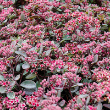
Plant Height: 6 inches
Flower Height: 10 inches
Spacing: 12 inches
Sunlight: full sun, partial shade
Hardiness Zone: 2b
Other Names: Autumn Stonecrop, Showy Stonecrop
Description:
A stunningly attractive perennial for hot, dry locations, featuring succulent bluish-green foliage and dark purple stems all season long, with showy pink flowers in late summer; a compact variety of stonecrop that also boasts excellent fall color
Ornamental Features:
Vera Jameson Stonecrop has masses of beautiful clusters of rose flowers at the ends of the stems from late summer to late fall, which emerge from distinctive coral-pink flower buds, and which are most effective when planted in groupings. The flowers are excellent for cutting. Its attractive succulent round leaves are bluish-green in color. As an added bonus, the foliage turns a gorgeous burgundy in the fall. The deep purple stems are very colorful and add to the overall interest of the plant.
Landscape Attributes:
Vera Jameson Stonecrop is a dense herbaceous perennial with an upright spreading habit of growth. Its medium texture blends into the garden, but can always be balanced by a couple of finer or coarser plants for an effective composition.
This is a relatively low maintenance plant, and is best cleaned up in early spring before it resumes active growth for the season. It is a good choice for attracting bees and butterflies to your yard, but is not particularly attractive to deer who tend to leave it alone in favor of tastier treats. It has no significant negative characteristics.
Vera Jameson Stonecrop is recommended for the following landscape applications:
- Mass Planting
- Rock/Alpine Gardens
- Border Edging
- General Garden Use
- Groundcover
- Container Planting
Planting & Growing:
Vera Jameson Stonecrop will grow to be only 6 inches tall at maturity extending to 10 inches tall with the flowers, with a spread of 15 inches. When grown in masses or used as a bedding plant, individual plants should be spaced approximately 12 inches apart. Its foliage tends to remain low and dense right to the ground. It grows at a fast rate, and under ideal conditions can be expected to live for approximately 15 years. As an herbaceous perennial, this plant will usually die back to the crown each winter, and will regrow from the base each spring. Be careful not to disturb the crown in late winter when it may not be readily seen!
This plant does best in full sun to partial shade. It is very adaptable to both dry and moist growing conditions, but will not tolerate any standing water. It is considered to be drought-tolerant, and thus makes an ideal choice for a low-water garden or xeriscape application. It is not particular as to soil pH, but grows best in poor soils, and is able to handle environmental salt. It is highly tolerant of urban pollution and will even thrive in inner city environments. This particular variety is an interspecific hybrid. It can be propagated by division; however, as a cultivated variety, be aware that it may be subject to certain restrictions or prohibitions on propagation.
Vera Jameson Stonecrop is a fine choice for the garden, but it is also a good selection for planting in outdoor pots and containers. It is often used as a 'filler' in the 'spiller-thriller-filler' container combination, providing a mass of flowers and foliage against which the larger thriller plants stand out. Note that when growing plants in outdoor containers and baskets, they may require more frequent waterings than they would in the yard or garden.
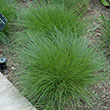
Purple bloom. Upright foliage with blue base. Fall color. Native. USDA 3-9
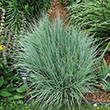
Bronze blooms. Blue-pink tinged foliage. Upright. Native. USDA 3-9
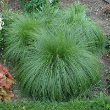
Plant Height: 24 inches
Flower Height: 3 feet
Spread: 3 feet
Sunlight: full sun, partial shade
Hardiness Zone: 2a
Description:
Native to the Great Plains and Prairies, this extremely fine-textured grass features airy plumes of fine seed heads floating over the grassy foliage in the late season; ideal for restoration projects and flowing hummocky accents in the urban landscape
Ornamental Features:
Prairie Dropseed features delicate plumes of orange flowers rising above the foliage from late summer to early fall. The tan seed heads are carried on showy plumes displayed in abundance from early to late fall. Its threadlike leaves are light green in color. As an added bonus, the foliage turns a gorgeous harvest gold in the fall.
Landscape Attributes:
Prairie Dropseed is an open herbaceous perennial grass with a shapely form and gracefully arching stems. It brings an extremely fine and delicate texture to the garden composition and should be used to full effect.
This is a relatively low maintenance plant, and is best cleaned up in early spring before it resumes active growth for the season. Deer don't particularly care for this plant and will usually leave it alone in favor of tastier treats. It has no significant negative characteristics.
Prairie Dropseed is recommended for the following landscape applications:
- Mass Planting
- General Garden Use
- Naturalizing And Woodland Gardens
Planting & Growing:
Prairie Dropseed will grow to be about 24 inches tall at maturity extending to 3 feet tall with the flowers, with a spread of 3 feet. Its foliage tends to remain dense right to the ground, not requiring facer plants in front. It grows at a medium rate, and under ideal conditions can be expected to live for approximately 10 years. As an herbaceous perennial, this plant will usually die back to the crown each winter, and will regrow from the base each spring. Be careful not to disturb the crown in late winter when it may not be readily seen!
This plant does best in full sun to partial shade. It is very adaptable to both dry and moist locations, and should do just fine under typical garden conditions. It is considered to be drought-tolerant, and thus makes an ideal choice for a low-water garden or xeriscape application. It is not particular as to soil type or pH, and is able to handle environmental salt. It is somewhat tolerant of urban pollution. This species is native to parts of North America.
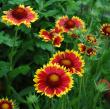
Prolific yellow-tipped red blooms. Compact. USDA 3-9
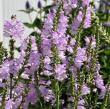
Pink blooms. Compact habit. Slow spreading cultivar. USDA 3-9
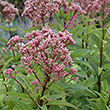
Large fragrant pink blooms. Upright bushy habit. USDA 3-9
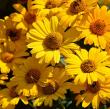
Compact. Bright yellow flowers. Heat and drought tolerant. Long bloomer. USDA 3-9
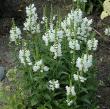
Height: 3 feet
Spacing: 30 inches
Sunlight: full sun partial shade
Hardiness Zone: 2a
Other Names: False Dragonhead
Ornamental Features:
Miss Manners Obedient Plant has masses of beautiful spikes of white hooded flowers rising above the foliage from mid summer to early fall, which are most effective when planted in groupings. The flowers are excellent for cutting. Its pointy leaves remain dark green in color throughout the
season.
Landscape Attributes:
Miss Manners Obedient Plant is an herbaceous perennial with an upright spreading habit of growth. Its medium texture blends into the garden, but can always be balanced by a couple of finer or coarser plants for an effective composition.
This is a relatively low maintenance plant, and is best cleaned up in early spring before it resumes active growth for the season. It is a good choice for attracting butterflies to your yard. It has no significant negative characteristics.
Miss Manners Obedient Plant is recommended for the following landscape applications:
- Mass Planting
- General Garden Use
Planting & Growing:
Miss Manners Obedient Plant will grow to be about 30 inches tall at maturity, with a spread of 3 feet. When grown in masses or used as a bedding plant, individual plants should be spaced approximately 30 inches apart. It tends to be leggy, with a typical clearance of 1 foot from the ground, and should be underplanted with lower-growing perennials. It grows at a medium rate, and under ideal conditions can be expected to live for approximately 10 years. As an herbaceous perennial, this plant will usually die back to the crown each winter, and will regrow from the base each spring. Be careful not to disturb the crown in late winter when it may not be readily seen! This plant does best in full sun to partial shade. It is very adaptable to both dry and moist locations, and should do just fine under typical garden conditions. It is not particular as to soil type or pH. It is highly tolerant of urban pollution and will even thrive in inner city environments. This is a selection of a native North American species. It can be propagated by division; however, as a cultivated variety, be aware that it may be subject to certain restrictions or prohibitions on propagation.
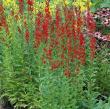
Scarlet-red bloom on green foliage. Prefers rich, humusy, medium to wet soils. Great for rain gardens. USDA 3-9
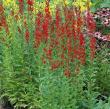
Scarlet-red bloom on green foliage. Prefers rich, humusy, medium to wet soils. Great for rain gardens. USDA 3-9
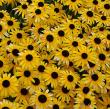
Height: 18 inches
Spacing: 10 inches
Sunlight: full sun
Hardiness Zone: 3a
Other Names: Orange Coneflower, Black Eyed Susan
Ornamental Features:
Viette's Little Suzy Coneflower has masses of beautiful yellow daisy flowers with dark brown eyes at the ends of the stems from mid summer to mid fall, which are most effective when planted in groupings. The flowers are excellent for cutting. Its serrated pointy leaves remain dark green in color throughout the season.
Landscape Attributes:
Viette's Little Suzy Coneflower is an herbaceous perennial with an upright spreading habit of growth. Its medium texture blends into the garden, but can always be balanced by a couple of finer or coarser plants for an effective composition.
This is a relatively low maintenance plant, and should be cut back in late fall in preparation for winter. It is a good choice for attracting butterflies to your yard, but is not particularly attractive to deer who tend to leave it alone in favor of tastier treats. It has no significant negative characteristics.
Viette's Little Suzy Coneflower is recommended for the following landscape applications:
- Mass Planting
- Border Edging
- General Garden Use
- Container Planting
Planting & Growing:
Viette's Little Suzy Coneflower will grow to be about 15 inches tall at maturity, with a spread of 12 inches. When grown in masses or used as a bedding plant, individual plants should be spaced approximately 10 inches apart. It grows at a fast rate, and under ideal conditions can be expected to live for approximately 15 years. As an herbaceous perennial, this plant will usually die back to the crown each winter, and will regrow from the base each spring. Be careful not to disturb the crown in late winter when it may not be readily seen!
This plant should only be grown in full sunlight. It prefers to grow in average to moist conditions, and shouldn't be allowed to dry out. It is not particular as to soil type or pH. It is highly tolerant of urban pollution and will even thrive in inner city environments. This is a selection of a native North American species. It can be propagated by division; however, as a cultivated variety, be aware that it may be subject to certain restrictions or prohibitions on propagation.
Viette's Little Suzy Coneflower is a fine choice for the garden, but it is also a good selection for planting in outdoor pots and containers. It is often used as a 'filler' in the 'spiller-thriller-filler' container combination, providing a mass of flowers against which the larger thriller plants stand out. Note that when growing plants in outdoor containers and baskets, they may require more frequent waterings than they would in the yard or garden.
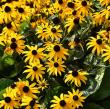
Prolific daisy-like blooms. Long bloomer. Self-seeding. Native. USDA 3-9
16 found, showing page 1 of 2







